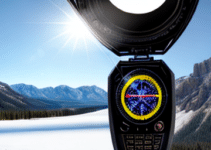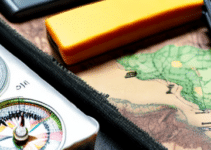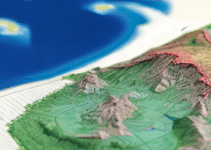Weather maps are crucial for survival situations, especially when combined with emergency maps and backcountry maps for reliable navigation in the wilderness. These maps display current and forecasted weather conditions, including temperature, precipitation, wind patterns, and atmospheric pressure.
By studying weather maps, you can anticipate changes in the weather, prepare for extreme conditions, and make decisions that will keep you safe.
While GPS and digital maps are convenient, physical maps such as topographic maps, navigation maps, and weather maps are essential for survival situations.
They provide important information about the land, help with navigation
‘Click here to learn more about: ‘ patriot
Essential Maps for Survival Kit
When it comes to preparing a survival kit, having the right maps, such as GPS maps or satellite maps, is crucial. Maps can be a lifeline, whether you find yourself in unfamiliar terrain or need to stay informed about weather conditions.
There are three essential types of maps to consider: topographic maps, navigation maps, and weather maps.
Each of these serves a specific purpose and can greatly enhance your chances of survival.
Let's take a closer look at each map and how it can be an invaluable tool in your survival kit
Enhancing Survival Skills with Navigation Maps
In addition to topographic maps, there are various other types of maps such as aerial maps and satellite imagery that can greatly enhance survival skills. These include desert maps, forest maps, island maps, cave maps, underground maps, aerial maps, satellite imagery, geospatial maps, digital maps, paper maps, waterproof maps, weatherproof maps, and foldable maps.
Each of these specialized maps provides specific information and details that are crucial for navigating through different environments and terrains.
Desert maps are particularly useful in arid regions as they highlight water sources and shelter locations.
On the other hand, forest maps help identify trails and wildlife paths in dense woodlands. When navigating across bodies of water, island maps become essential. Cave maps are essential for explorers delving into the uncharted depths of the underground.
Various Types of Maps
- Aerial maps provide a bird's-eye view of the terrain, offering a comprehensive understanding of the landscape.
- Satellite imagery captures real-time images of the Earth's surface, allowing for accurate mapping and monitoring of changes over time.
- Geospatial maps utilize geographic data to create detailed visual representations, aiding in spatial analysis and decision-making.
- Digital maps offer the convenience of accessibility and interactive features, making them ideal for navigation on electronic devices.
Importance of Topographic Maps for Navigating Rugged Terrains
Having a topographic map is essential for a safe and successful outdoor experience, especially when equipped with reliable and current maps.
Topographic maps provide a wealth of information that is crucial for navigation.
They not only show the features of the landscape, but also provide details on elevation, contours, and other topographical information.
This allows outdoor enthusiasts to plan their routes effectively and make informed decisions about potential obstacles and hazardous areas.
The elevation and contour lines displayed on topographic maps are particularly useful for assessing the steepness of slopes. This information helps adventurers gauge the level of challenge a particular route presents, allowing them to adjust their plans accordingly. By knowing the terrain, outdoor enthusiasts can rely on easy-to-read, laminated maps to navigate their way through nature's beauty effortlessly.
Choosing the Right Outdoor Maps for Backpacking and Camping
When selecting outdoor maps for backpacking and camping, it's important to consider their size and weight, as well as ensuring they are compact and lightweight for easy portability. Opting for compact and lightweight maps is a great way to minimize the weight of your gear.
This is especially beneficial for backpackers who want to keep their load as light as possible.
Another crucial factor to keep in mind is durability.
Your maps should be able to withstand rough conditions and frequent use. This ensures that they remain intact throughout your journey and continue to be reliable navigational tools.
In addition to these considerations, it's also a good idea to have emergency preparedness maps and survival navigation tools. These can provide an extra layer of safety in case of unexpected situations. Having access to these resources can help you navigate and find your way using map reading skills, map interpretation, and map symbols.
Selecting Outdoor Maps
- Compact and lightweight maps are essential for easy portability during backpacking and camping trips.
- Opting for compact and lightweight maps helps minimize the weight of your gear, allowing backpackers to keep their load as light as possible.
- Durable maps are crucial as they can withstand rough conditions and frequent use, ensuring they remain intact throughout your journey.
- Having emergency preparedness maps and survival navigation tools provides an extra layer of safety in case of unexpected situations during outdoor adventures.
Valuable Tool Orienteering Maps for Wilderness Navigation
Orienteering maps, created through cartography and terrain analysis, are an essential tool for wilderness navigation as they provide valuable information on geographical features, landmarks, natural resources, and geographical boundaries, benefiting hikers, backpackers, and outdoor enthusiasts. These maps go beyond traditional cartography and incorporate terrain analysis and geographical features to create detailed navigational aids.
They include landmarks, natural resources, geographical boundaries, and urban and rural areas, offering a comprehensive view of the surrounding environment.
Orienteering maps provide precise geographical data and geographic coordinates, such as latitude and longitude, enabling adventurers to accurately pinpoint their location and plan their routes accordingly. With their scale ratio and geographical positioning, these cartography experts can accurately analyze terrain, map geographical features and landmarks, assess natural resources, determine geographical boundaries, and differentiate urban and rural areas based on precise geographical data, geographic coordinates, and latitude and longitude.
Benefits of Hiking Maps in Backcountry Exploration
Hiking maps are essential tools for backcountry exploration, providing numerous benefits for outdoor enthusiasts, including route planning, direction finding, landmark identification, emergency evacuation routes, search and rescue operations, communication towers, emergency shelters, water sources, food sources, medical facilities, danger zones, safe zones, and access to emergency contacts. These maps offer crucial information for route planning, direction finding, and landmark identification, allowing hikers to confidently navigate unfamiliar terrains.
In case of emergencies, hiking maps are invaluable for emergency evacuation routes and search and rescue operations.
These maps highlight significant features like communication towers, emergency shelters, water sources, food sources, and medical facilities, offering hikers vital information for their well-being and safety. Hiking maps aid in identifying danger zones and safe zones, including crucial information on emergency evacuation routes, communication towers, and emergency shelters.
Benefits of Hiking Maps
- Hiking maps provide crucial information for route planning, allowing hikers to navigate unfamiliar terrains confidently.
- In case of emergencies, hiking maps offer invaluable information on emergency evacuation routes and aid in search and rescue operations.
- These maps highlight significant features like communication towers, emergency shelters, water sources, and medical facilities, ensuring hikers have vital information for their well-being and safety.
- Hiking maps also help identify danger zones and safe zones, providing information on emergency evacuation routes, communication towers, and emergency shelters.
Significance of Waterproof Maps in Emergency Preparedness
Waterproof maps are essential for emergency preparedness in the wilderness, ensuring reliable navigation and orientation even in the most remote backcountry areas. These maps are made from a special material that is resistant to water, tearing, and fading, making them perfect for use in harsh weather conditions.
Unlike regular paper maps, waterproof maps can withstand heavy rain, snow, and accidental submersion without becoming damaged or unreadable.
One key advantage of waterproof maps is their detailed topographic information.
This information provides valuable insights into the terrain, making it easier to navigate through challenging wilderness areas. Whether you are hiking, camping, backpacking, or exploring the backcountry, having a waterproof map with detailed topographic information can significantly enhance your safety and well-being.
In addition to topographic information, waterproof maps also contain crucial data on nearby shelters, evacuation routes, and emergency services. This information is vital in developing survival strategies during emergencies. By having access to cartographic tools and a compass, hikers can confidently navigate the wilderness and overcome any challenges posed by topography or geography for a successful backpacking trip in the backcountry.
Aid of GPS Maps and Satellite Imagery in Survival Navigation
Maps are another crucial component of survival navigation, especially when exploring remote areas without GPS or satellite coverage. By depicting current weather patterns, such as temperature, precipitation, and wind conditions, these maps help adventurers anticipate and prepare for weather changes.
This knowledge is essential for making informed decisions regarding clothing, shelter, and travel routes.
Weather maps can provide valuable information about potential hazards, such as storms or extreme temperatures.
This allows adventurers to adjust their plans accordingly and seek shelter or take necessary precautions to avoid dangerous situations.
In conclusion, GPS maps and satellite imagery, along with topographic, navigation, and weather maps, are indispensable tools in survival navigation.
By providing detailed information, precise positioning, and weather updates, these technologies enable adventurers to navigate unfamiliar terrains with confidence and ensure their safety
Maps in Survival Navigation
- Maps help adventurers anticipate and prepare for weather changes by depicting current weather patterns, such as temperature, precipitation, and wind conditions.
- Weather maps provide valuable information about potential hazards, such as storms or extreme temperatures, allowing adventurers to adjust their plans accordingly and seek shelter or take necessary precautions to avoid dangerous situations.
- GPS maps and satellite imagery, along with topographic, navigation, and weather maps, are indispensable tools in survival navigation as they provide detailed information, precise positioning, and weather updates.
- By using these technologies, adventurers can navigate unfamiliar terrains with confidence and ensure their safety.
Role of Contour Maps in Terrain Analysis for Survival Planning
And having a clear understanding of their locations can make a significant difference in a survival situation, especially when equipped with a geospatial map that provides detailed imagery of the forest or island terrain. Contour maps can help individuals locate water sources by identifying low-lying areas or depressions where water is more likely to collect.
By analyzing the contour lines, one can also determine the direction in which the water will flow, thereby aiding in the navigation towards these vital resources.
Whether it is for drinking, cooking, or hygiene purposes, knowing the location of water sources is crucial for survival planning.
Contour maps can assist individuals in assessing the impact of weather conditions on their survival strategies. By examining the contour lines, one can identify areas that are prone to flooding, avalanche, or other weather-related hazards.
This knowledge enables individuals to plan their routes and campsites accordingly, avoiding potentially dangerous areas and ensuring their safety during adverse weather conditions. In survival situations, having a waterproof and weatherproof map can be crucial for navigating through the treacherous forest or finding shelter in an underground cave.
Emergency Navigation Tools Choose Wisely
Essential Navigation Tools for Emergencies





